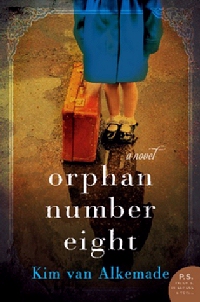
Orphan Number 8
by Kim van Alkemade
William Morrow, 2015
Reviewed by Barbara Free
and Jenna Wiley
The story begins in 1918, a time when orphanages and orphan trains were not only common, but the only places for children to go if a parent died or could not afford to care for them. There were no foster-care systems, no adoption agencies as we know them, no group homes, and no assistance for single parents. Some children’s homes did exist that gave loving, excellent care, and some did not adopt out the children in their care, but many did, and many were unnecessarily regimented and even abusive. Some orphanages had 1,000 or more children, and many children grew up there for years. The institutions in the story, and the real places they are based upon, were among such huge establishments.
Some of the characters in this book are real people who existed or are based upon actual individuals, while others are fictional but based on composites of actual persons. The author, who has written non-fiction before this, learned much of this history from her grandfather and great-grandmother, both of whom are characters in the story. She did a great deal of research to ascertain the actual facts and based the story on things that did happen and other things that might have happened.
In 1918, orphans or children of single parents had little chance for good lives unless they were taken in by family or foster parents, which was rare. In this story, the main character, Rachel Rabinowitz, and her brother, Sam, were little children whose parents were Jewish refugees from Russia, and they were living in a tenement in New York City. Their parents got into fight and the father killed the mother, then ran away out of fear. A kind neighbor took them to the Jewish Children’s Agency, the only thing she knew to do.
From there, they went to the orphanages mentioned above, where some doctors were conducting research on the effects of medications, diets, and X-rays. These experiments did actually take place, as the author was able to confirm. They are harrowing to read about, but an important part of what was happening in those years. One particular doctor, a woman, experimented on the children, including Rachel, with huge amounts of radiation in the belief that tonsils could be destroyed with X-rays instead of surgery. It was common practice, clear up through the 1950s, even in normal, middle-class families, for all the children to have tonsils and adenoids removed, even though healthy, as a matter of course.
As a result of this radiation, Rachel loses all her hair, forever. She and her brother grow up in this place, where the kindest person they meet is a Mrs. Berger, who works there so she can see her own three children, placed there because her husband ran off and left them. She and her son are the author’s actual great-grandmother and -grandfather. The story is fictional, but more than believable.
The story is told in chapters alternating between Rachel’s childhood, told in third person, and Rachel’s adult life in the early 1950s, when she is a nurse, told in first person. Most of the book is set in New York City, with some trips to Leadville and Denver, Colorado, and Chicago. Later developments in her adult life connect to her childhood in ways that the reader does not see until the last pages of the book.
This is an excellent, well-written book that tells a compelling story, such that the reader may not want to put it down, even though it is a haunting story. One might be advised not to read it at night, lest it give one nightmares.
Excerpted from the January 2016 edition of the Operation Identity Newsletter
© 2016 Operation Identity